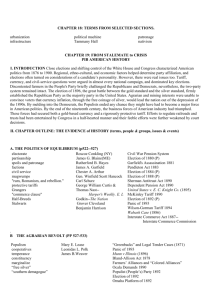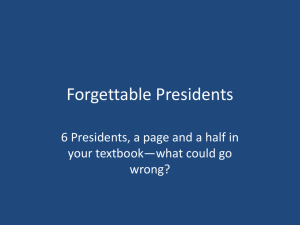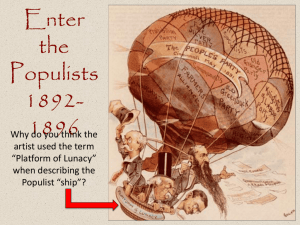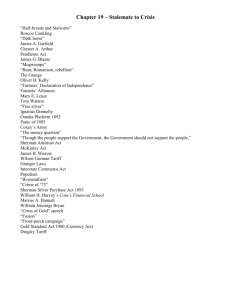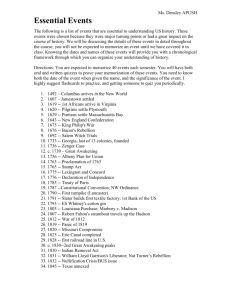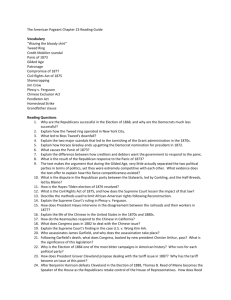Ch 17 & 19 Study Guide
advertisement
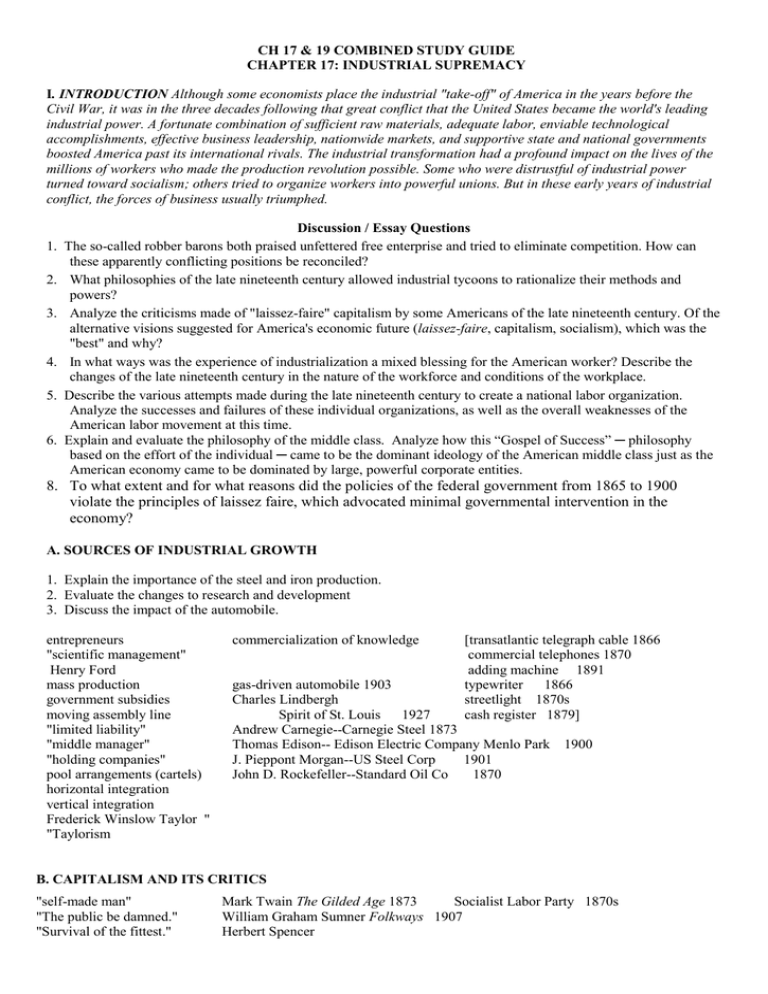
CH 17 & 19 COMBINED STUDY GUIDE CHAPTER 17: INDUSTRIAL SUPREMACY I. INTRODUCTION Although some economists place the industrial "take-off" of America in the years before the Civil War, it was in the three decades following that great conflict that the United States became the world's leading industrial power. A fortunate combination of sufficient raw materials, adequate labor, enviable technological accomplishments, effective business leadership, nationwide markets, and supportive state and national governments boosted America past its international rivals. The industrial transformation had a profound impact on the lives of the millions of workers who made the production revolution possible. Some who were distrustful of industrial power turned toward socialism; others tried to organize workers into powerful unions. But in these early years of industrial conflict, the forces of business usually triumphed. 1. 2. 3. 4. 5. 6. Discussion / Essay Questions The so-called robber barons both praised unfettered free enterprise and tried to eliminate competition. How can these apparently conflicting positions be reconciled? What philosophies of the late nineteenth century allowed industrial tycoons to rationalize their methods and powers? Analyze the criticisms made of "laissez-faire" capitalism by some Americans of the late nineteenth century. Of the alternative visions suggested for America's economic future (laissez-faire, capitalism, socialism), which was the "best" and why? In what ways was the experience of industrialization a mixed blessing for the American worker? Describe the changes of the late nineteenth century in the nature of the workforce and conditions of the workplace. Describe the various attempts made during the late nineteenth century to create a national labor organization. Analyze the successes and failures of these individual organizations, as well as the overall weaknesses of the American labor movement at this time. Explain and evaluate the philosophy of the middle class. Analyze how this “Gospel of Success” ─ philosophy based on the effort of the individual ─ came to be the dominant ideology of the American middle class just as the American economy came to be dominated by large, powerful corporate entities. 8. To what extent and for what reasons did the policies of the federal government from 1865 to 1900 violate the principles of laissez faire, which advocated minimal governmental intervention in the economy? A. SOURCES OF INDUSTRIAL GROWTH 1. Explain the importance of the steel and iron production. 2. Evaluate the changes to research and development 3. Discuss the impact of the automobile. entrepreneurs "scientific management" Henry Ford mass production government subsidies moving assembly line "limited liability" "middle manager" "holding companies" pool arrangements (cartels) horizontal integration vertical integration Frederick Winslow Taylor " "Taylorism commercialization of knowledge [transatlantic telegraph cable 1866 commercial telephones 1870 adding machine 1891 typewriter 1866 streetlight 1870s cash register 1879] gas-driven automobile 1903 Charles Lindbergh Spirit of St. Louis 1927 Andrew Carnegie--Carnegie Steel 1873 Thomas Edison-- Edison Electric Company Menlo Park 1900 J. Pieppont Morgan--US Steel Corp 1901 John D. Rockefeller--Standard Oil Co 1870 B. CAPITALISM AND ITS CRITICS "self-made man" "The public be damned." "Survival of the fittest." Mark Twain The Gilded Age 1873 Socialist Labor Party 1870s William Graham Sumner Folkways 1907 Herbert Spencer Social Darwinism "invisible hand" "conspicuous consumption" "unearned increment" "single tax" monopoly Andrew Carnegie The Gospel of Wealth 1901 Horatio Alger Henry George Progress and Poverty 1879 Patterns of Popular Culture: The Novels of Horatio Alger C. INDUSTRIAL WORKERS IN THE NEW ECONOMY 1. Discuss the sources of labor 2. Evaluate the wages and working conditions for laborers. 3. Why did the unions have little success by the end of the nineteenth century? injunction Panic of 1873 Labor Contract Law x1885 collective bargaining Terrance V. Powderly Ancient Order of Hibernians "anarchism" Knights of Labor 1869 Molly Maguires Samuel Gompers 1886 Great RR Strike 1877 AFL Haymarket Square 1886 Eugene V. Debs Pullman Strike 1894 Homestead Strike 1892 Pinkerton Detective Agency CHAPTER 19: FROM STALEMATE to CRISIS I. INTRODUCTION Close elections and shifting control of the White House and Congress characterized American politics from 1876 to 1900. Regional, ethno-cultural, and economic factors helped determine party affiliation, and elections often turned on considerations of a candidate’s personality. However, there were real issues too. Tariff, currency, and civil-service questions were argued in almost every national campaign, and dominated key elections. Discontented farmers in the People's Party briefly challenged the Republicans and Democrats, nevertheless, the twoparty system remained intact. The election of 1896, the great battle between the gold standard and the silver standard, firmly established the Republican Party as the majority party in the United States. Agrarian and mining interests were unable to convince voters that currency inflation, through the free coinage of silver, would lead the nation out of the depression of the 1890s. By melding into the Democrats, the Populists ended any chance they might have had to become a major force in American politics. By the end of the nineteenth century, the business forces of American industry had triumphed. These forces had secured both a gold-based currency and a rigorously protective tariff. Efforts to regulate railroads and trusts had been entertained by Congress in a half-hearted manner and their feeble efforts were further weakened by court decisions. A. THE POLITICS OF EQUILIBRIUM (p522--527) Rutherford B. Hayes electorate James A. Garfield factions Chester A. Arthur civil service Thomas Nast-protective tariffs Harper's Weekly. Grangers "commerce clause" B THE AGRARIAN REVOLT Populism “Greenbacks” and Legal Tender Cases (1871) cooperatives Panic of 1893 temperance Munn v Illinois (1896) constituency Bland-Allison Act 1878 Civil War Pension System Pendleton Act 1883 Sherman Antitrust Act 1890 Dependent Pension Act 1890 United States v. E. C. Knight Co. (1895) McKinley Tariff 1890 Panic of 1893 Wilson-Gorman Tariff 1894 Wabash Case (1886) Interstate Commerce Act 1887-Interstate Commerce Commission Farmers’ Alliances and “Colored Alliances” Ocala Demands 1890 Omaha Platform of 1892 Populist (People’s) Party 1892 marginalize “free silver” “southern demagogue” C. THE CRISIS OF THE 1890s Contraction of credit Jacob Coxey Bankruptcy Coxey’s Army (1894) Inflation “Crime of 73”—Coinage Act of 1873 Bimetallism Sherman Silver Purchase Act of 1890 Panic of 1893 Repeal of Sherman Silver Purchase Act 1893 POPULISM D. "A CROSS OF GOLD" William Jennings Bryan "...you shall not crucify mankind upon a cross of gold." ""Cross of Gold speech " 1896 “whistlestop campaign” William McKinley “The Great Commoner" Dingley Tariff 1897 Gold Standard (Currency) Act 1900 E. CONCLUSION III. ADDITIONAL READINGS Omaha Morning World-Herald: Populist Party Platform (1892) Lease: The Money Question (1892) McDonald-Valesh: The Strength and Weakness of the People's Movement (1892) p98 p101 p102 Morion; U of Illinois: Bryan: p104 p105 p106 What Farm Problem? (1896) Republican Party Platform of 1896 from The "Cross of Gold" Speech (1896) Constructed Response Questions 1) Compare and contrast the three different stages of the agrarian revolt that developed between the 1860s and 1890s. Describe how the movement became more and more political. 2) Discuss the causes and the effects of the Panic of 1893. 3) Compare and contrast the political philosophies and the campaign styles of the two major candidates for president in 1896. 4) Describe and analyze the rapid rise and fall of the Populist Party. Discuss the Party’s platform in the context of the 1890s.
